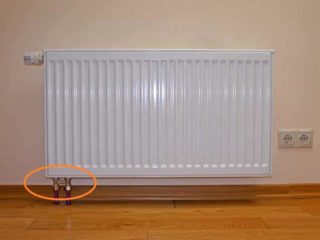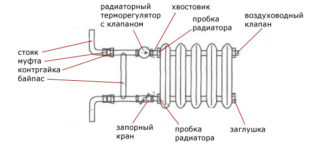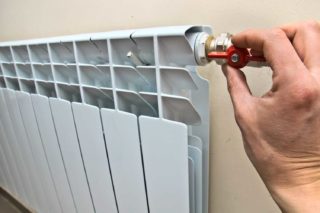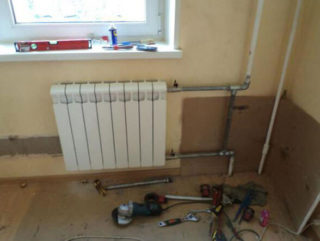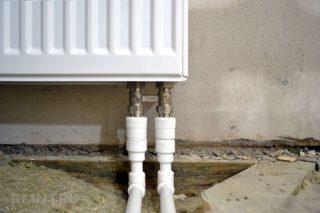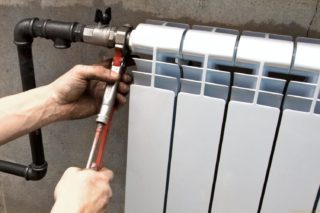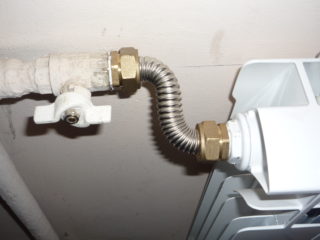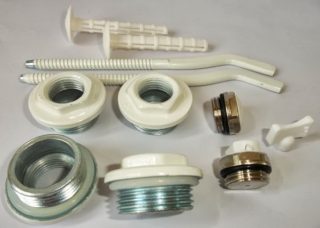Used equipment is dismantled and replaced with new equipment to improve the thermal conditions in the room. Removing the heating battery is a simple process if you know how to remove the radiator correctly. Work is carried out in the summer so as not to drain the water from the highway. The thread is unscrewed or a grinder is used if a welded joint is used.
Situations for dismantling the radiator
Work is carried out independently in a technological sequence. The equipment is removed carefully if further use is required. The brackets must remain intact, otherwise they will require additional strengthening or replacement.
The batteries are removed for various reasons:
- Leaking between sections. The radiator key does not reach the nipples located behind the blind plugs. The heater is removed from the supply side.
- Leaking in the place of eyeliner on the drives. Dismantling is required to change the threaded pipe section.
- The need to replace the radiator with a device with other characteristics.
- Prevention Sections must be descaled and gaskets replaced.
- Repair in the room. The batteries are dismantled to decorate the wall behind them.
Removing the radiator is required if the system is redone, for example, from a one-pipe scheme in a two-pipe house.
Disassembly Methods
Removing the battery during the heating season occurs after the riser is emptied. In a private house, this concerns the owner, and in a high-rise building a permit is issued by the managing office. The service is paid and is carried out at a time convenient for utilities. Most heating appliances are equipped with blocking valves, the coolant stops flowing to a separate area.
Fitting connection
The thread remains intact if the center distance from one eyeliner to another in a new device is similar to an old battery.
Dismantling procedure:
- Locknuts are twisted along the plugs with plugs. If a layer of paint interferes, the connection is heated by a hairdryer or blowtorch. The old winding is removed from the thread.
- The radiator plug is untwisted using a gas key under number 3 or 4. Usually, right-hand thread is used for lateral connection.
- The radiator is removed from the holders.
- Radiator plugs and locking elements are twisted on the eyeliner.
The existing connections are cut off if it is planned to transfer the heater, install a faucet, a temperature regulator or re-mount it on American women. In fresh areas, a new cut is made for cranes or fittings.
With the help of driving
Tightness is ensured through the use of a system of two nuts. One connects the radiator to the pipe, the second is a lock nut. A smaller element is unscrewed along the length of the cut of the drive, then they also come with a connecting nut. The process is performed on the supply and return lines.
The radiator is removed from the mounts. Cast iron products are heavy, so help is needed, or the radiator is divided into separate sections. Water remains in the battery, so rags are used so as not to flood the neighbors.
The problem appears when the joints are rusted and become stationary. The blowtorch helps or the docking places are cut off. The remaining length may not be enough for a new cut, so an additional bend is welded.
Coolant shutdown
Before unscrewing the battery, turn off the system and drain the water. In individual heating, to remove the battery, empty the circuit from the stove.
In a multi-story building, options depend on the design of the heating system:
- The apartments of the new building have a separate circuit. Water is shut off by a tap embedded in the path from the riser to the radiator.
- In the old residential sector, water is turned off in a common riser, and the valve is in the basement.
- The latest settings are with a bypass insert on the battery. The specified valve opens, the coolant supply valve is shut off, after 5-7 minutes, the outlet valve is turned off.
It is easy to disassemble a bimetal heating radiator or an aluminum battery, because a Mayevsky tap is installed on them for safe draining of water. On low-cost models, a stub is installed, unscrewed with a wrench. The thread is right and left, accuracy is required so as not to break it.
Top connection
In this wiring variant, the shut-off valve is located in the attic. It overlaps, but the plug remains in place. In the basement, the common riser and distribution of the return are turned off. In the attic, the plug rotates a couple of revolutions and you need to wait until the pressure of the water flowing down the cut decreases. The decrease in pressure indicates the health of the locking devices.
The plug is completely unscrewed. Hanging coolant will merge after opening the supply pipe to the battery.
Bottom connection
The riser is overlapped, on which the radiator is changing, and two neighboring ones. On adjacent vertical pipes, valves overlap to detect a twin riser. Then the cap is unscrewed on its own and the cranes on the neighboring ones are started in turn. Opening the shut-off device in a double riser will cause the coolant to discharge. This tap closes, the second starts.
The seat or bottom connection is made with a two-pipe system, a valve for shutting off is mounted on the outlet and inlet of the pipes. The valve is closed, the pipes are disconnected, the pipes are shifted to the sides or down, the radiator is removed from the brackets.
On american
The nuts have a right-hand thread and are screwed using a pipe or open-end wrench. You can remove the heating battery in an American apartment in a short period of time. The supply pipes are separated from the radiator plug by 3-5 mm, then the battery is removed from the hooks. Sometimes it takes effort to straighten the steel liners in the case of a diagonal connection.
An American for pipes made of polypropylene is characterized by the presence of a clamping nut, unlike other fittings. To disconnect the heating equipment, it is twisted until the return section becomes free. Then part of the nozzle is removed from the battery.
Old fittings squeeze outlets of the crane, over time, the cutting takes the form of a mating part and is not reused. In this case, the slope or shutoff valve changes.
Batterys batteries
If the connection is on one side, the plugs have a right-hand thread. The diagonal connection is characterized in that one of the bushings will have a left. The opposite movement is indicated by the letter A on the surface of the cork located on the same side.
A pipe wrench is used to rotate the cast iron plug. Sometimes it is necessary to heat the collector of the right section, which will lead to easy unscrewing. The bend is simultaneously screwed into the radiator while unscrewing the left sleeve. If there is a thread on the eyeliner, the converter plug is not removed, and the flare is dismantled from the coupling. It slides into the cork hole, and after removing the battery, it exits the socket effortlessly.
Welding battery
Welded joint refers to the non-separable types, so the places of hoses are cut by a grinder or hacksaw. For a power tool, a metal wheel is used. The cut is directed at right angles to the longitudinal axis. A new thread is made to connect a battery made of cast iron or bimetal; elongation of the underwater and outlet sections by welding may be required.
Materials used
Steel galvanized pipes are used to change the system or lengthen the connections to the heating batteries. They are joined by threaded joints, welding is not used. The melting point of steel is + 1400 ° C, and zinc - + 900 ° C. Zinc completely evaporates in the weld area.
Components required:
- blind and bushings;
- two shut-off valves;
- paired locknuts when installed on drives, their size corresponds to the diameter of the hoses;
- brackets for fixing the convector to the wall.
Sometimes stainless corrugated pipes are used. Durable products bend, compression fittings installed with adjustable wrenches are taken for connection.
Wall Mount Radiators
One ball valve is changed to a thermal head or valve to coordinate the degree of heating and cooling of heating equipment. The throttle (valve) is manually adjusted, and the thermostatic element works automatically.
Residents of the upper floors put air vents on radiators to remove accumulated air. Mayevsky's cranes or automatic devices are being installed. In a multi-story building, the battery connections are equipped with a jumper to valves or chokes. The connection provides movement of water in the riser when the underwater section is closed. Full or partial closure of the supply line without a jumper will lead to cooling of the batteries at the neighbors.
Installation of bushing and blind plugs
The grouping of sectional collectors is completed by installing the bushings in the required combination, which depends on the circuit. Traffic jams are deaf and passing. Deaf elements do not have through holes, and the external thread does not differ from the through holes.
Feed-through products feature a central hole. Both types are available with left and right-handed turns, since there are two corresponding inputs in the battery section. You can turn the sleeve on a lathe made of steel, cast iron or brass.
Pressure test
Joints are checked under pressure after hanging and connecting heating equipment. An electric or manual compressor is used to pump atmospheric air. A check is carried out to detect leaks in the system.
Procedure:
- shut-off valves are closed;
- plugs are wrapped and air vents are closed on risers;
- on the riser, one valve opens and slowly fills;
- after the cessation of hissing sound, both cranes start fully:
- leaks are monitored inside the housing;
- shut-off valves in the supply areas slowly open.
First, the lower valve is actuated, then the air is removed through the Mayevsky valve, then the upper supply valve opens.
The airing is completely removed from the riser if the heating in the house is mounted according to a system with a lower filling. This is done in the apartment of the residents of the upper floor.
